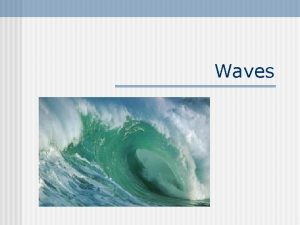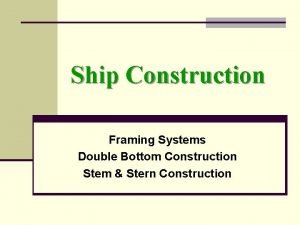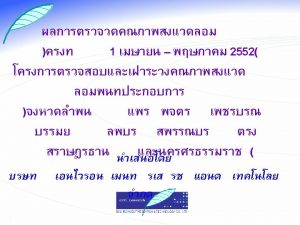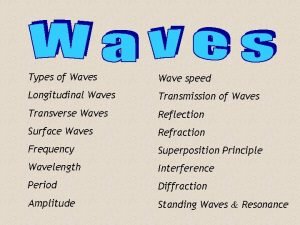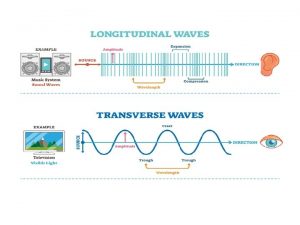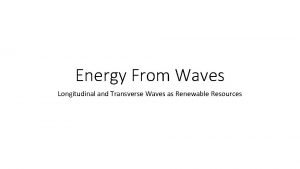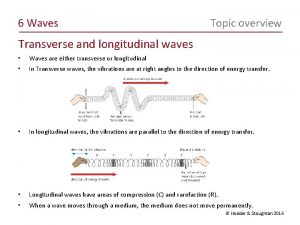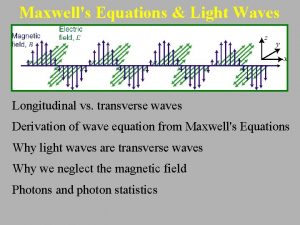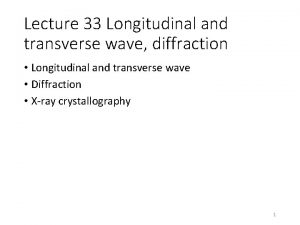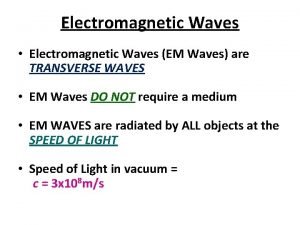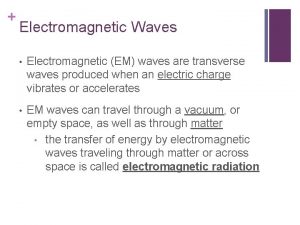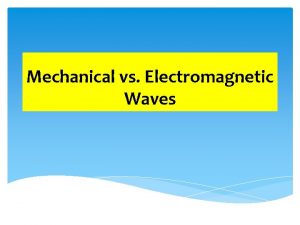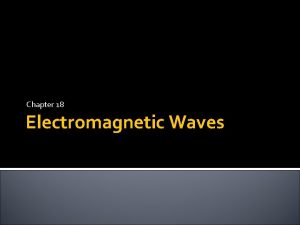Waves I Characteristics of Waves Transverse waves Longitudinal












- Slides: 12

Waves I. Characteristics of Waves Ø Transverse waves Ø Longitudinal waves Ø Measuring waves

ØReview: Period Vs Frequency

A. Waves Ø Waves w rhythmic disturbances that carry energy through matter or space Ø Medium w material through which a wave transfers energy w solid, liquid, gas, or combination w electromagnetic waves don’t need a medium (e. g. visible light)

A. Waves ØTwo Types: Longitudinal Transverse

B. Transverse Waves ØTransverse Waves w medium moves perpendicular to the direction of wave motion

B. Transverse Waves ØWave Anatomy corresponds to the amount of energy carried by the wave crests wavelength amplitude nodes trough wavelength

C. Longitudinal Waves ØLongitudinal Waves (a. k. a. compressional) w medium moves in the same direction as wave motion

C. Longitudinal Waves ØWave Anatomy compression rarefaction wavelength Amount of compression corresponds to amount of energy AMPLITUDE.

D. Measuring Waves ØFrequency ( f ) w # of waves passing a point in 1 second w Hertz (Hz) w shorter wavelength higher frequency higher energy 1 second

D. Measuring Waves ØVelocity ( v ) w speed of a wave as it moves forward w depends on wave type and medium v= ×f v: velocity (m/s) : wavelength (m) f: frequency (Hz)

D. Measuring Waves Ø EX: Find the velocity of a wave in a wave pool if its wavelength is 3. 2 m and its frequency is 0. 60 Hz. WORK: v= ×f GIVEN: v=? = 3. 2 m f = 0. 60 Hz v = (3. 2 m)(0. 60 Hz) v v = 1. 92 m/s f

D. Measuring Waves Ø EX: An earthquake produces a wave that has a wavelength of 417 m and travels at 5000 m/s. What is its frequency? WORK: f=v÷ GIVEN: = 417 m v = 5000 m/s f=? v f = (5000 m/s) ÷ (417 m) f = 12 Hz f
 Compression and rarefaction
Compression and rarefaction Transverse vs longitudinal waves
Transverse vs longitudinal waves Longitudinal vs transverse waves
Longitudinal vs transverse waves Wave unit test answer key
Wave unit test answer key Sound is a longitudinal wave
Sound is a longitudinal wave Sound waves are transverse waves true or false
Sound waves are transverse waves true or false Lobes in the brain
Lobes in the brain Transverse framing system ship
Transverse framing system ship Ship construction
Ship construction Vertical
Vertical Wavelength formula triangle
Wavelength formula triangle Difference between abdominal cavity and peritoneal cavity
Difference between abdominal cavity and peritoneal cavity List of longitudinal waves
List of longitudinal waves

